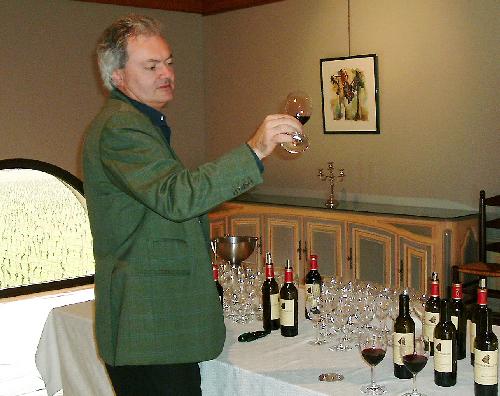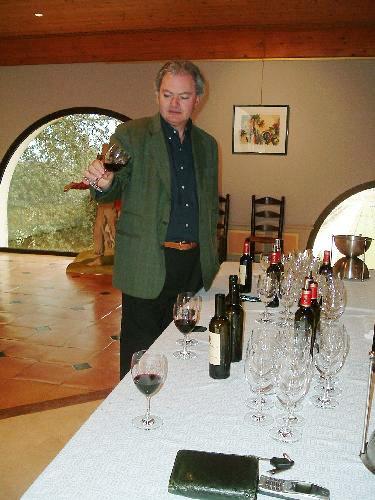 |
| The Independent Traveler's Newsletter PAGE SIX |
 |
| The Independent Traveler's Newsletter PAGE SIX |
| Château Angélus continued . . . |
|
One of the appellation's most highly prized wines – and rising stars in the higher echelons – is Château Angélus. Promoted into the top 13 in the last re-evaluation in 1996, there is talk that it may join Ausone and Cheval Blanc, if not in 2006, then in 2016. Most of the wine is exported which makes it, oddly enough, sometimes less expensive in the United States than in France, though prices on both sides of the Atlantic are hardly cheap. Reflecting the impeccable quality of the wine, an average vintage can cost up to $80 a bottle, with a great vintage, like 1989, fetching as much as $300 a bottle. Less than a mile from the famous bell tower at Saint Emilion on its renowned south facing “pied de côte” (foot of the hill) site, Château Angélus is the story of four generations of the Boüard de la Forest family. The estate's name derives from an ancient vineyard, from which the men tending the vines could hear the angélus ringing out from all three of the town's churches: the Chapelle de Mazerat, the Church of Saint Martin de Mazerat and the Church of Saint Emilion. At the turn of the century, Maurice de Boüard de la Forest acquired the then three-hectare plot (about seven and half acres), adding it to the adjacent vineyard, Château Mazerat, which had been in the family since 1850. Sons Jacques and Christian expanded the holding by buying adjoining plots of land, until by the 1970s, they had completed the property run today by Hubert de Boüard de la Forest and his cousin Jean-Bernard Grenié.  
Hubert de Boüard de la Forest at a tasting of his Château Angélus wines The promotion was the result of hard work from both de la Forest and Grenié. They introduced the philosophy of picking riper grapes, advocated by Emile Peynaud, the grandfather of modern French winemaking, who also taught de la Forest personally. Regrettably, Peynaud passed away this year, but his influence lives on today. Many winemakers, wine lovers and critics praise his approach and impact to winemaking, from Robert Parker to Hugh Johnson. But beyond picking riper grapes, the owners also declassified grapes from lesser plots to make a second wine – something many châteaux do in Bordeaux – and have concentrated all the best plots for their Château Angélus blend, which includes a high proportion of Cabernet Franc, a grape that lends a mentholated freshness to their wine. The owners also keep up with technology while respecting traditional methods, so that each harvest and each vintage achieves as much as possible. Recently in Bordeaux and then on Nantucket Island – during the 8th Annual Nantucket Wine Festival in May – I was able to taste the wine in both vertical and horizontal tastings. In wine lingo, a vertical means that one tastes several different years – usually contiguous – of the same wine, in this case Angélus. A horizontal means the opposite: tasting different wines, but from the same year. While in Bordeaux during the primeur tasting of the latest 2003 Bordeaux vintage – the vintage is tasted roughly six months after the harvest, after having had some time in the barrel – I was impressed by the quality of Angélus in a vintage that was not most favorable to Merlot. It stood out among many of its peers in the horizontal tasting in late March. Two months later on Nantucket, I hosted the vertical tasting for wine festival participants. The eight wines tasted, spanning 12 years, illustrated the consistent quality one obtains from this château and is explanation enough for its recent promotion. As follows, my brief tasting notes: 2001: Very young and tight – which is expected from a wine that was bottled less than a year ago. A very good if not great year. But put the bottle away, and wait for it to open up in about five years. 2000: All I could say was “Wow.” A very full-bodied and balanced wine, though still very young with hints of tannin that will melt over time. A great vintage overall in Bordeaux, and very successful for this château. Prices reflect this success, with this bottle fetching about $225 on today's market. 1998: Almost as good as the 2000, though more compact. Does not have the enormous aromatic qualities of the 2000 but still very good. 1996: Leaner than either the 1998 or the 2000, more similar to the 2001, but properly aged with a very smooth Cabernet Franc freshness to it that is appealing. Very well done. 1995: This wine was tasting no less than heavenly and upstaged all of the wines of the tasting, with the exception of the 1989. Full-bodied, yet nuanced, the wine's tannin has melted and the result is a balanced flavor that one will also obtain from the more recent vintages. 1994: Not the favorite among some of the wine tasters at the festival, I really enjoyed this wine for its mineral qualities and smoothness. It is certainly not as full-bodied as, say, the 1995 or the 2000, but offers fine taste. 1990: A great year in Bordeaux and a great wine. I thought it was tasting a tad stolidly at this stage, although it was lovely in aromas and flavor. When tasting wine, one must always remember that each vintage ages differently. The 1990 – a great vintage in Bordeaux – was among the very best of this vertical tasting, but will improve with time. 1989: This wine got my nod for best of the bunch along with the 1995. It was full-bodied, mature, elegant and packed with flavor. The next time you go to Bordeaux, don't miss Saint Emilion and Château Angélus. A look at the well-done web site will give you more information about this exceptional château, which always welcomes visitors. You just need to call ahead. And, if you ever make it to Nantucket Island in May, check out the wine festival which features hundreds of wines from all over the world – in a wonderful setting! Visit
these web sites for more on Château Angélus wines and the
recent tastings: http://www.angelus.com
and
Panos Kakaviatos
is an American who lives in both Europe and the United States
[Photos used
in this article are the copyrighted property of Panos Kakaviatos.]
DISCLAIMER: You have received this newsletter because your email address is on our Opt-In mailing list, i.e., you have requested to receive FRANCE On Your Own ©. If you would like to discontinue receipt of this newsletter, please send an email to publisher@franceonyourown.com with "unsubscribe" on the Subject line. Unless indicated otherwise, photos, graphics and text in the FRANCE On Your Own © newsletter are the property of Cold Spring Press and FRANCE On Your Own © and cannot be copied, duplicated or used in any manner by anyone without the express written permission of Cold Spring Press. FRANCE On Your Own © is published on line by Cold Spring Press, P O Box 26098, San Diego, California 92196-0098. This publication is copyrighted and no portions of the text, artwork, graphics or photographs may be reproduced or distributed in any form or by any means or stored in a database or retrieval system without the written permission of the Publisher. For more information about FRANCE On Your Own ©, visit our web site at http://www.franceonyourown.com. Recommendations made in this newsletter are based upon the personal experiences of the Publishers or contributing writers solely to provide information to subscribers. Cold Spring Press and FRANCE On Your Own © make no endorsements nor are any guarantees or promises of satisfaction given or implied. Any and all information is correct to the best of our knowledge, and the Publishers accept no responsibility for errors and/or omissions. The responsibility lies entirely with the traveler to obtain current information regarding accommodations, availability, schedules, prices, reservations, or any other pertinent details. We do not guarantee the historical accuracy of the contents of articles in this newsletter. Historical accuracy is dependent upon one’s sources of information -- and contradictions often exist among those sources. FRANCE On Your Own © is electronically transmitted via email. To add your email address to our database for this FREE newsletter, send an email to info@franceonyourown.com, and please put Subscribe in the subject line. We do not share email addresses with any other organization. BACK ISSUES of the print version of FRANCE On Your Own © are available on our web site at http://www.franceonyourown.com/Archives.htm.
|